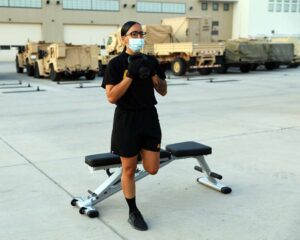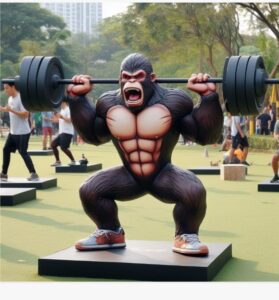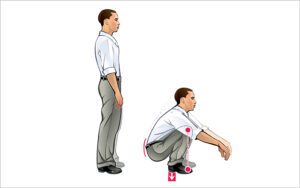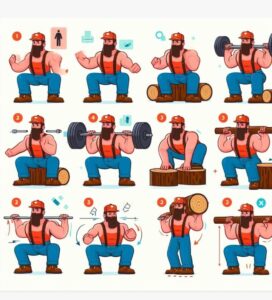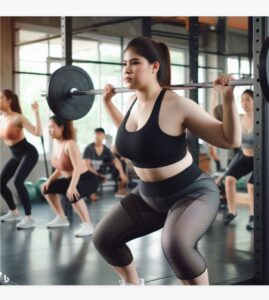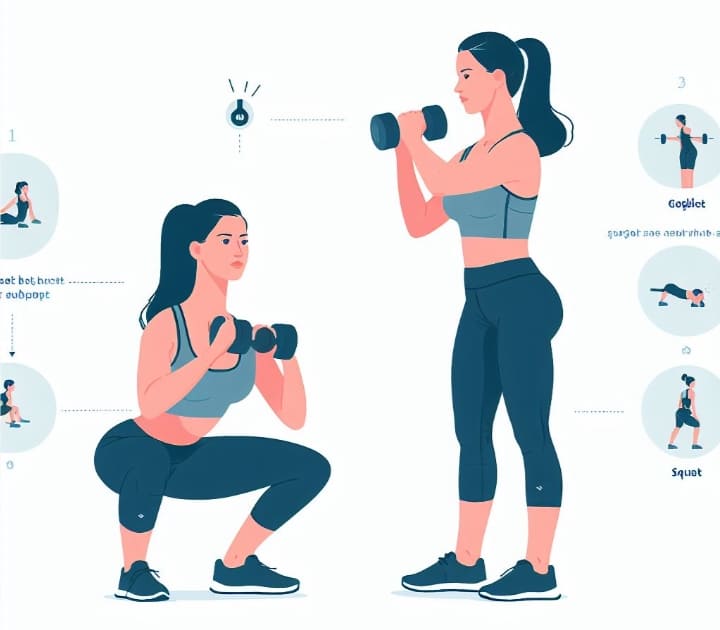
Goblet squats are a highly effective exercise that targets the lower body, providing a multitude of benefits for individuals of all fitness levels.
This compound movement primarily engages the quadriceps, hamstrings, glutes, and core muscles, making it an excellent choice for building lower body strength and stability.
In this article, we will explore the 10 proven benefits of goblet squats and why incorporating them into your fitness routine can lead to significant improvements in overall strength and functional movement.
Before we dive into the unique and amazing benefits of goblet squats, lets talk about the mechanism and techniques of this exercise first
Understand Goblet Squat
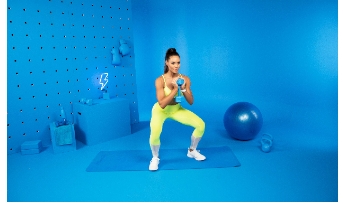
Goblet squats are a type of squat exercise that involves holding a weight—typically a dumbbell or kettlebell—in front of the chest while performing a squat. The term “goblet” refers to the way the weight is held, cradled in front of the body like a goblet, which helps maintain a proper posture and center of gravity throughout the movement.
Muscles worked:
- Quadriceps
- Hamstrings
- Glutes
- Core
- Calves (back of the lower legs)
- Forearms (muscles at the back of the lower arm)
- Trapezius (Large muscles at the back of the upper neck and shoulder)
How to do Goblet Squats with Proper Form
To do goblet squats with proper form, follow these steps:
- Stand with your feet shoulder-width apart and hold a kettlebell or dumbbell in front of your chest with both hands. The kettlebell should be centered in front of your body, with the handle resting on the inside of your fingers.
- Brace your core and engage your glutes.
- Squat down by bending your knees and pushing your hips back. Keep your back straight and your chest up.
- Lower down until your thighs are parallel to the ground or as low as you can go without compromising your form. Make sure your knees do not track past your toes.
- Drive through your heels to stand back up.
Tips for proper form
Here are some tips for maintaining proper form:
- Keep your core engaged throughout the entire movement. This will help to protect your back and maintain your balance.
- Keep your back straight and your chest up. Avoid slouching or rounding your shoulders.
- Don’t let your knees collapse inward. Your knees should track over your toes as you squat down and stand back up.
- Keep your weight evenly distributed throughout your feet. This will help to prevent injuries and improve your balance.
- Squat as low as you can without compromising your form. If you can’t squat all the way down to parallel, that’s okay. Just go as low as you can comfortably.
If you are new to goblet squats, start with a light weight and gradually increase the weight as you get stronger. You can also consult with a qualified personal trainer or strength and conditioning coach to learn proper form and technique.
Common mistakes to avoid
Here are some common mistakes to avoid when doing goblet squats:
- Not engaging the core. This can lead to back pain and injury.
- Rounding the back. This can also lead to back pain and injury.
- Letting the knees collapse inward. This can put stress on the knees and lead to injury.
- Not squatting low enough. This will not fully work the muscles in the legs and glutes.
- Using too much weight. This can lead to injury.
By following these tips, you can ensure that you are performing goblet squats with proper form and maximizing the benefits of this exercise.
Variations:
- Goblet squat with a biceps curl: At the bottom of the squat, curl the kettlebell or dumbbell up to your shoulders. Then, lower the weight back down as you stand back up.
- Goblet squat to box: At the bottom of the squat, step out with one leg and rotate your hips so that your body is facing sideways. Then, step back in and rotate your hips back to the starting position before standing back up.
- Weighted goblet squat: Hold a weight in each hand as you perform the goblet squat.
- Goblet squat with a jump: At the top of the squat, jump up and land softly with your knees bent. Then, lower back down into the squat.
Now that will know what goblet squat is, how to do them with proper form, their targeted muscles and variations, its time for to explore the 10 unique and proven benefits of goblet squats and how the provide these benefits
10 Benefits of Goblet Squats
Goblet squats, often underestimated in the realm of fitness, offer a myriad of benefits and advantages that cater to individuals across various fitness levels. Let’s delve into the ten proven and unique benefits of goblet squats and explore how this exercise contributes to a holistic approach to fitness.
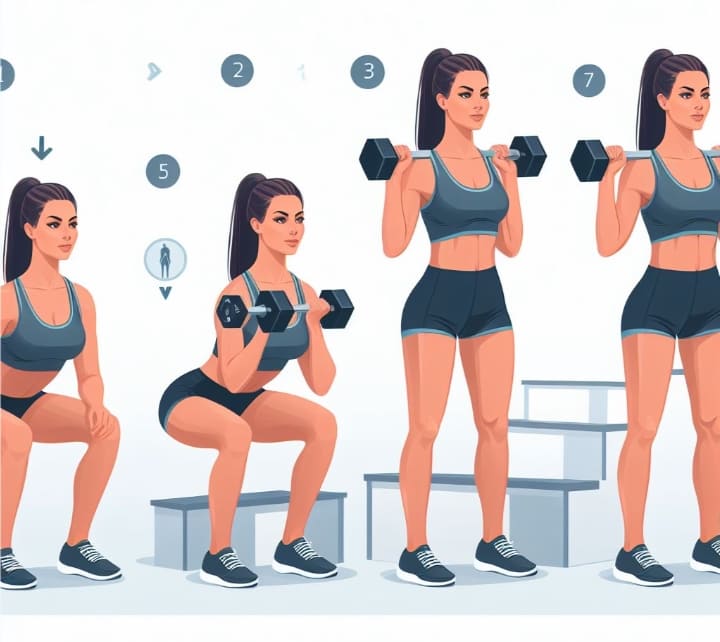
Benefit #1: Increased quad, hamstring, and glute strength and hypertrophy
Goblet squats provide increased quad, hamstring, and glute strength and hypertrophy through a number of mechanisms:
- Muscle overload: Goblet squats require the quadriceps, hamstrings, and glutes to work against a load, which helps to stimulate muscle growth.
- Mechanical tension: The front-loaded position of the goblet squat places more tension on the quadriceps. This can help to increase quadriceps strength and hypertrophy.
- Metabolic stress: Goblet squats are a compound exercise that works multiple muscle groups. This creates metabolic stress, which can also contribute to muscle growth.
- Neuromuscular activation: Goblet squats require the quadriceps, hamstrings, and glutes to work together in a coordinated manner. This can help to improve neuromuscular activation, which can lead to greater muscle strength and hypertrophy.
Benefit #2: Improved core strength and stability
Goblet squats provide improved core strength and stability through a number of mechanisms:
- The front-loaded position of the goblet squat forces the core to work hard to maintain balance and stability. This is because the weight of the kettlebell or dumbbell is in front of the body, which creates a forward-pulling force.
- The need to maintain a neutral spine throughout the entire movement requires the core to be engaged. This helps to protect the back and spine from injury.
- The deep squatting position of the goblet squat requires the core to be strong and stable. This is because the core muscles are responsible for stabilizing the spine and pelvis during deep movements.
- The compound nature of the goblet squat requires the core to work together with the lower body muscles to generate force and power. This helps to develop the core muscles and improve their strength and stability.
Benefits #3: Reduced stress on the back and shoulders
Goblet squats reduce stress on the back and shoulders in a number of ways:
- The front-loaded position of the goblet squat shifts the weight of the load away from the back and shoulders. This can help to reduce stress on the spine and shoulder joints.
- The goblet squat allows you to maintain a more upright posture than other types of squats. This can help to reduce stress on the lower back.
- The goblet squat is a compound exercise that works multiple muscle groups, including the core muscles. Strong core muscles help to support the spine and pelvis, which can reduce stress on the back.
- The goblet squat is a relatively low-impact exercise. This means that it is less likely to cause stress on the joints than other types of exercises, such as running or jumping.
In addition to these benefits, goblet squats also provide a number of other benefits that can help to reduce stress, such as:
- Increased endorphin levels: Exercise releases endorphins, which have mood-boosting and stress-relieving effects.
- Improved sleep quality: Exercise can help to improve sleep quality, which can reduce stress levels.
- Reduced muscle tension: Exercise can help to reduce muscle tension, which can be a source of stress.
Overall, goblet squats are a great exercise for reducing stress on the back and shoulders. They are safe, effective, and versatile.
Benefits #4: Improved hip mobility and range of motion
Goblet squats can help to improve hip mobility and range of motion in a number of ways:
- The front-loaded position of the goblet squat requires the hips to flex more than other types of squats. This can help to improve the mobility of the hip flexors, which are the muscles responsible for flexing the hip joint.
- The deep squatting position of the goblet squat requires the hips to abduct and externally rotate more than other types of squats. This can help to improve the mobility of the hip abductors and external rotators, which are the muscles responsible for moving the thigh away from the body and rotating the thigh outward, respectively.
- The compound nature of the goblet squat requires the hips to work together with the lower body muscles to generate force and power. This can help to improve the neuromuscular coordination of the hip muscles, which can lead to better hip mobility and range of motion.
In addition to these mechanisms, goblet squats also provide a number of other benefits that can contribute to improved hip mobility and range of motion, such as:
- Increased muscle strength: The muscles that control the hip joint, such as the hip flexors, abductors, and external rotators, are all strengthened by goblet squats. Increased muscle strength can lead to improved hip mobility and range of motion.
- Reduced muscle tension: Goblet squats can help to reduce muscle tension in the hips and surrounding areas. This can improve hip mobility and range of motion.
- Improved blood flow: Goblet squats can help to improve blood flow to the hips and surrounding areas. This can help to improve hip mobility and range of motion by nourishing the muscles and joints.
Benefit #5: Improved shoulder mobility
- The front-loaded position of the goblet squat requires the shoulders to be internally rotated. This can help to improve the mobility of the shoulder internal rotators, which are the muscles responsible for rotating the humerus (upper arm bone) inward.
- The deep squatting position of the goblet squat requires the shoulders to be extended. This can help to improve the mobility of the shoulder extensors, which are the muscles responsible for extending the humerus backward.
- The compound nature of the goblet squat requires the shoulders to work together with the upper body muscles to generate force and power. This can help to improve the neuromuscular coordination of the shoulder muscles, which can lead to better shoulder mobility.
In addition to these mechanisms, goblet squats also provide a number of other benefits that can contribute to improved shoulder mobility, such as:
- Increased muscle strength: The muscles that control the shoulder joint, such as the internal rotators and extensors, are all strengthened by goblet squats. Increased muscle strength can lead to improved shoulder mobility.
- Reduced muscle tension: Goblet squats can help to reduce muscle tension in the shoulders and surrounding areas. This can improve shoulder mobility.
- Improved blood flow: Goblet squats can help to improve blood flow to the shoulders and surrounding areas. This can help to improve shoulder mobility by nourishing the muscles and joints.
Benefit #6: Increased explosive power and athletic performance
- The goblet squat is a dynamic exercise that requires the muscles to generate force and power quickly. This can help to improve explosive power and athletic performance.
- The compound nature of the goblet squat requires multiple muscle groups to work together to generate force and power. This can help to improve overall athletic performance.
- The front-loaded position of the goblet squat challenges the core muscles to maintain balance and stability. This can help to improve core strength, which is essential for explosive power and athletic performance.
In addition to these mechanisms, goblet squats also provide a number of other benefits that can contribute to increased explosive power and athletic performance, such as:
- Increased muscle recruitment: Goblet squats require the recruitment of a large number of muscle fibers, which can lead to greater explosive power.
- Improved neuromuscular activation: Goblet squats activate the muscles more effectively than other exercises, such as leg presses. Increased muscle activation leads to greater explosive power.
- Reduced risk of injury: A strong and stable core is essential for preventing injuries, especially in the lower back and shoulders. Goblet squats can help to strengthen and stabilize the core, which can reduce the risk of injury and improve athletic performance.
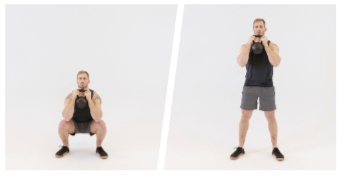
Benefit #7: Improved Cardiovascular Health:
Goblet squats, although primarily a strength-building exercise, can contribute to cardiovascular health by incorporating a form of resistance training. Here’s how they affect cardiovascular health:
- Increased Heart Rate: Goblet squats engage multiple muscle groups, demanding energy and oxygen. As a result, heart rate increases during the exercise, promoting cardiovascular endurance and conditioning.
- Caloric Expenditure: Goblet squats being a compound exercise, involving multiple muscle groups, elevate the metabolic rate, leading to an increased caloric burn. This not only assists in fat loss but also supports overall cardiovascular health by enhancing the efficiency of the heart and circulatory system.
Benefit #8: Increased Bone Density:
Resistance training, such as goblet squats, positively influences bone density by subjecting bones to stress and loading. Here’s how it contributes to increased bone density:
- Weight-Bearing Exercise: Goblet squats, particularly with added weights, impose stress on bones, stimulating them to adapt by becoming denser and stronger. This type of weight-bearing exercise is beneficial for bone health, reducing the risk of osteoporosis and improving bone density.
- Whole-Body Engagement: The pressure on the skeletal system during the squat movement, especially on the hips and lower body, stimulates bone growth and remodeling, promoting better bone density and resilience.
Benefit #9: Improved Posture:
Goblet squats directly impact posture by emphasizing correct spinal alignment and engagement of core muscles. Here’s how they aid in enhancing posture:
- Core Activation: Maintaining an upright position during goblet squats requires significant engagement of the core muscles. This engagement stabilizes the spine and encourages a straighter, more aligned posture.
- Spinal Alignment: Holding the weight in front of the chest promotes an upright torso, encouraging individuals to maintain a neutral spine. This focus on proper alignment during the exercise helps in reinforcing good posture habits in everyday activities.
Benefit #10: Reduced Risk of Injury:
Goblet squats, when performed correctly, help prevent injury by strengthening muscles, improving balance, and promoting better movement mechanics. Here’s how they mitigate the risk of injury:
- Muscle Strengthening: Engaging multiple muscle groups, including the quadriceps, hamstrings, and core, builds overall strength, which supports the body in performing other exercises and daily activities, reducing the risk of strain or injury.
- Enhanced Balance and Stability: Goblet squats challenge balance and stability due to the weight being held in front of the body. Regularly practicing this exercise improves balance and stability, reducing the likelihood of falls or injuries.
- Correct Movement Patterns: The focus on proper form and controlled movement in goblet squats instills correct movement patterns. This reduces the risk of injury not only during the exercise itself but also in other physical activities by promoting better body mechanics and technique.
The recommended frequency, reps, and sets for goblet squats for maximum benefits vary depending on your individual goals, fitness level, and experience. However, a good general rule of thumb is to perform goblet squats 2-3 times per week for 3 sets of 8-12 repetitions.
If you are an experienced lifter and your goal is to maximize strength, you may want to perform goblet squats 3-4 times per week for 3 sets of 5-8 repetitions. If your goal is to maximize muscle mass, you may want to perform goblet squats 2-3 times per week for 3 sets of 10-12 repetitions.
Here is a sample goblet squat workout for maximum benefits:
Warm-up:
- 5 minutes of light cardio, such as jogging or jumping jacks
- 10 goblet squats with no weight or a very light weight
Workout:
- 3 sets of 8-12 repetitions of goblet squats
Cool-down:
- 5 minutes of light cardio
- 10 stretches for the quadriceps, hamstrings, and glutes
Conclusion
Goblet squats are a valuable addition to any fitness regimen, offering a multitude of benefits for individuals aiming to improve strength, stability, and overall health. Incorporating goblet squats into your workout routine, with proper form and consistency, can yield significant gains in various aspects of physical fitness.
Focus on proper form and technique to maximize the benefits and minimize the risk of injury.
Related Posts
Reference:
https://barbend.com/benefits-of-the-goblet-squat/
https://www.health.com/fitness/goblet-squats
https://barbend.com/benefits-goblet-squats/
https://www.healthline.com/health/fitness-exercise/dumbbell-goblet-squat
https://www.americansportandfitness.com/blogs/fitness-blog/crush-your-leg-day-7-benefits-of-goblet-squats https://www.medicinenet.com/what_does_a_goblet_squat_work/article.htm


